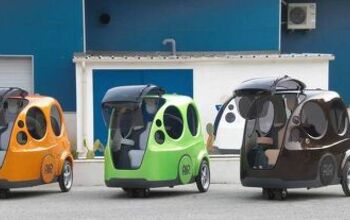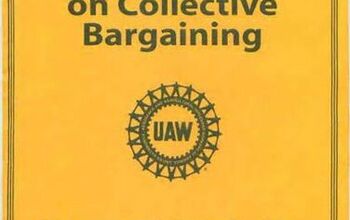Put Your Hands Up for Detroit
Everything either grows or dies. As The Big Two Point Five face the New Year, they’d do well to remember this. All the talk about “market share stabilization,” “matching production to demand,” and “right-sizing” is merely an attempt to obscure the simple fact that they’re dying. I know: that’s a pretty depressing sentiment for automakers still staggering about with an SUV-sized hangover. But death is a normal part of life; a precursor to rebirth. As 2006 dies, 2007 beckons. Here’s a guide to what Detroit faces– must face– in the year ahead.
This is the year that Toyota will supplant Ford as America’s Number Two automaker and replace General Motors as the world’s Number One. These two milestones will provide incontrovertible proof that The Big Two Point Five’s day is over (at least for now). The damage flowing from that increasingly obvious fact will be both subtle and, ultimately, devastating. For one thing, the best and brightest have a natural aversion to working on a sinking ship. BMW, Mercedes, Honda, Toyota and Hyundai will continue to cherry pick the industry’s top management, designers, engineers, production experts and marketers. The little discussed Detroit brain drain will exact a heavy toll.
Secondly, as Mr. Neundorf has written, the rearranging of America’s automotive pantheon will end the average consumer’s ignorance of Detroit’s distress. The media buzzards have been circling The Big Two Point Five for some time, refraining from swooping down because of their collective ignorance, [misplaced] respect and simple disinterest. Once Toyota punts Ford, GM and Chrysler down the sales ladder, the 2.5’s anguish will become carrion feeder catnip. How did the foreigners kick America’s ass again? What does it mean for our country’s industrial base? Although reporters will focus on turnarounds and comebacks– at least initially– the cumulative effect will corrode consumer confidence.
This is also the year that Detroit must finally shuck the union straightjacket– and won’t. Analysts who predict that the United Auto Workers’ (UAW) will come to the negotiating table with “a new sense of realism” (or some such set of code words indicating a supposed readiness to take a hit for the team) will be proven wrong. Once again, there will be some kind of media-friendly slight-of-hand. Last year, GM’s workers “gave up” a $1 an hour wage hike– which actually went straight to their health care compensation. They also “gave back” health care benefits in exchange for a not-as-well-publicized $3b health care VEBA. This is the new template for Detroit labor relations.
By topping-up their coffers, GM and Ford have virtually guaranteed a continuation of union intransigence. In fact, management happy talk about incipient turnarounds makes it highly unlikely that they’ll do the only thing they can do to wrest control of their companies back from the UAW: face down a UAW strike. Wagoner (GM) and Mulally (Ford) have a long history of playing ball with the unions. They’re less likely to exercise the nuclear option against the UAW than the US is against the UAE. Chrysler’s German owners are also strike-aversive; what with the need to keep the company solvent enough to sell. So it’ll be [less and less] business as usual.
In ’07, The Big Two Point Five will all feel the cash burn. If the economy slows down or gas prices go way up, it’ll be a fully-fledged conflagration. Meanwhile and in any case, the biggest threat to their existence is the same one that’s been nibbling away at them for the last three decades: new and/or improved products. We’ve already written about the new Toyota Tundra’s impact on The Big Two Point Five’s mission critical pickup truck margins. The transplants are also set to launch new or improved cars, crossovers and hybrids, and refreshes aplenty. The gap between the Big 2.5’s products and those of their competitors’ is not likely to narrow significantly this year.
Once again, the only real hope for The Big Two Point Five is cataclysmic change. Given their deep pockets, I don’t think Ford or Chrysler will file in ‘07, but there is a chance that circumstances (and their own ongoing incompetence) will force GM to face the inevitable. It could come from any number of different angles: a supplier “run on the bank,” a severe economic downturn, a tipping point-style loss of market share, a UAW strike, SEC criminal charges leading to chaos, a combination of these factors or something unexpected. If GM goes down, the ripple effect on suppliers will drag Ford under, and then Chrysler.
For The Big Two Point Five, ’07 will be a year much like the last, typified by denial, obfuscation and compromise. TTAC will be here chronicling the story. Rest assured we do so knowing that Americans produce some of the world’s best automobiles. One way or another, sooner or later, The Big Two Point Five will have to recreate themselves, to rise, Phoenix-like, from the ashes.
More by Robert Farago
Latest Car Reviews
Read moreLatest Product Reviews
Read moreRecent Comments
- V8fairy Not scared, but I would be reluctant to put my trust in it. The technology is just not quite there yet
- V8fairy Headlights that switch on/off with the ignition - similar to the requirement that Sweden has- lights must run any time the car is on.Definitely knobs and buttons, touchscreens should only be for navigation and phone mirroring and configuration of non essential items like stereo balance/ fade etc>Bagpipes for following too close.A following distance warning system - I'd be happy to see made mandatory. And bagpipes would be a good choice for this, so hard to put up with!ABS probably should be a mandatory requirementI personally would like to have blind spot monitoring, although should absolutely NOT be mandatory. Is there a blind spot monitoring kit that could be rerofitted to a 1980 Cadillac?
- IBx1 A manual transmission
- Bd2 All these inane posts (often referencing Hyundai, Kia) the past week are by "Anal" who has been using my handle, so just ignore them...
- 3-On-The-Tree I was disappointed that when I bought my 2002 Suzuki GSX1300R that the Europeans put a mandatory speed limiter on it from 197mph down to 186mph for the 2002 year U.S models.


































Comments
Join the conversation
From Automotive News... Ford CEO Alan Mulally and U.S. sales chief Cisco Codina told dealers and journalists Wednesday, Jan. 3, that the Fusion beat the Honda Accord and Toyota Camry in a consumer research event. Car and Driver magazine's business unit conducted the event in mid-December, a source said. Ford plans to tout the Fusion's win over the Camry and Accord in the ad campaign. The automaker will provide details to journalists and dealers today.
I really have to see a shrink about my masochistic tendency to sub to lists like this.